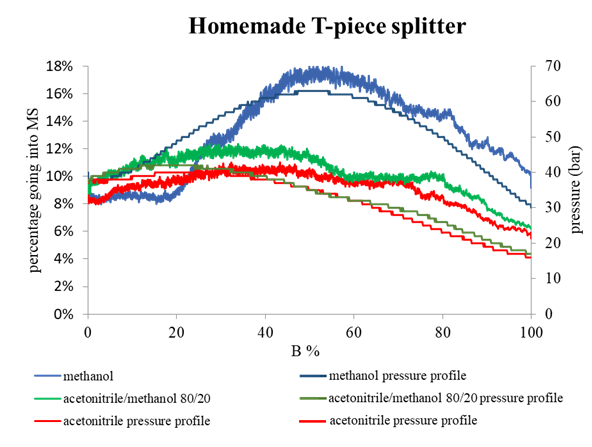Recently a study in Rapid Communications in Mass

Spectrometry was published. In this study, we optimized the actual split ratio and make-up flow composition in LC/ESI/MS analysis to increase the signal in radio detector and enhance the sensitivity of electrospray ionization.
High methanol content increases electrospray ionization efficiency
We studied make-up flow composition with a set of 20 pharmaceuticals covering 21 different make-up flow compositions. We studied methanol, acetonitrile, isopropanol and acetone as organic modifiers. As we studied positive mode the acidic additives under investigation were formic acid, oxalic acid and propionic acid. DMSO and sulfolane as additives were studied as well. The Methanol/10 mM formic acid in water (90/10) proved to be the best make‐up flow composition in relation to the average sensitivity obtained. Stronger acidic conditions using oxalic acid or higher formic acid concentrations had a clear positive effect on the sensitivity of compounds with low ionization efficiency.
Split-ratios remain stable over main part of the gradient
 The second part of this study was testing and monitoring different split ratios (1:10, 1:100 and 1:250) with different splitters (Alliance flow‐splitter kit and homemade T-piece splitter). To monitor the actual split ratio haloperidol solution was added with infusion pump post-column while a haloperidol-d4 solution was added as a make‐up flow by the ISM pump after the splitter. The tested split ratios were relatively stable over the main part of the gradient but showed some variation at very low and very high organic conditions. Differences were larger with methanol compared with acetonitrile containing solvent compositions and when applied without a column or with very long connecting tubing.
The second part of this study was testing and monitoring different split ratios (1:10, 1:100 and 1:250) with different splitters (Alliance flow‐splitter kit and homemade T-piece splitter). To monitor the actual split ratio haloperidol solution was added with infusion pump post-column while a haloperidol-d4 solution was added as a make‐up flow by the ISM pump after the splitter. The tested split ratios were relatively stable over the main part of the gradient but showed some variation at very low and very high organic conditions. Differences were larger with methanol compared with acetonitrile containing solvent compositions and when applied without a column or with very long connecting tubing.
I thank Janssen Pharmaceutica and especially Dr Filip Cuyckens for the internship position for letting to gain experience in an industry setting and study these effects. Additionally, I thank Erasmus+ mobility and Smart specialization doctoral stipend for funding my stay.


